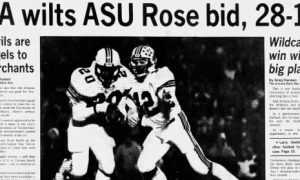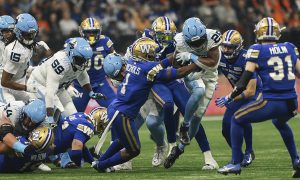[tps_title]NO. 39[/tps_title]
[tps_header]ASU ripe for picking in banana uniforms for “The Streak” to reach 8 games[/tps_header]
SCORE: Arizona Wildcats 28, ASU Sun Devils 10
DATE: Nov. 25, 1989
SITE: Sun Devil Stadium, a record 74,926 in attendance
WHY IT MADE THE LIST: Arizona State’s players looked like bananas, dressed in all yellow as a motivational ploy, but to Arizona, the Sun Devils were ripe for the picking.
The Wildcats continued their mastery of ASU in “The Streak”, extending their unbeaten run against their arch-rivals to eight games. The game was played in front of the largest crowd (74,926) to watch an Arizona-ASU game at Sun Devil Stadium. It also increased Arizona’s unbeaten streak in Tempe to four games (3-0-1), the longest such streak for the Wildcats at Sun Devil Stadium.
Jay Gonzales
From the Press Box — Jay Gonzales
During our countdown series, some media members and former players will offer their insight to a few of the games. Jay Gonzales, a former Arizona football beat reporter for the Arizona Daily Star, offers his memory of this game between Arizona and ASU in 1989.
“As a Star reporter covering this game, I recall thinking, ‘What the h-ll is going on with those uniforms?’ It took a fraction of a second for someone in the press box to comment that ASU looked like a bunch of bananas running on the field. After the game, I remember Glenn Parker saying something unprintable about the uniforms. Whoever thought of this idea at ASU should have been looking for another job after the game. People don’t remember the score of the game, but they remember the silly yellow uniforms.”

ASU’s Paul Justin could not back up his bold prediction to beat Arizona in the 1989 Territorial Cup game despite the all-yellow uniforms
David Eldridge scored twice on one-yard plunges in a 1:18 span of the third quarter to enable the Wildcats to pull away. Arizona, headed for the inaugural Copper Bowl in Tucson that year against North Carolina State, finished the regular season at 7-4 overall. Arizona State (6-4-1) had its three-game winning streak halted and was 0-7-1 against the Wildcats since 1982. It was the Sun Devils’ worst loss to Arizona since a 30-6 defeat in 1964 at Tucson.
Trying to change ASU’s luck in the series, Sun Devils coach Larry Marmie had his team swap its traditional maroon jerseys for new gold ones before the game. The move backfired as it got the Wildcats fired up.
“I remember in 1989 when they came out in warmups in maroon jerseys and no shoulder pads,” former Arizona linebacker Donnie Salum told the Tucson Citizen’s John Moredich in 2005. “We were wondering if they just weren’t taking us too seriously. Once the game started, they came out in their yellow uniforms, which (ESPN broadcaster) Chris Berman called their ‘banana uniforms.’
“They were the ugliest uniforms you will ever see,” Salum said. “And in that game I think they were, like, a 12-point favorite, and we put it to them. We came out of the locker room with everybody holding up eight fingers to show how the streak was going to go.”
Eldridge’s one-yard plunge 3:29 into the third quarter capped a 71-yard drive in nine plays to put Arizona ahead to stay, 14-10. Wildcat defensive tackle Reggie Johnson then sacked Arizona State’s Paul Justin on a first-down play, stripping the ball from him and recovering it at the Sun Devil nine. Three plays later, Eldridge dove over from the one-yard line to make it 21-10 with 10:08 left.
Michael Bates’ three-yard touchdown run with 7:10 left made it 28-10 and capped an 80-yard, 18-play drive — all on the ground — that took 8:59 off the clock. Bates (Amphitheater) and Eldridge (Pueblo) were from Tucson high schools. Eldridge finished with 104 yards in 25 carries as Arizona, the conference’s rushing offense leader with a 236.5-yard average, controlled the football for 41 of the game’s 60 minutes and had 285 of its 366 yards of total offense on the ground.
The Sun Devils had 350 yards of total offense — 307 of it passing as Justin completed 17 of 34 attempts but was sacked four times.
The crowd at Sun Devil Stadium topped the previous record of 74,911 at the Jan. 2 Fiesta Bowl game between Notre Dame and West Virginia for the 1988 national championship. The record was broken on Nov. 9, 1996, when 74,963 attended ASU’s 35-7 win over Cal.





























